With Walt Whitman in Camden: A Digital Edition
Matt Cohen, Editor
Former staff:
Nicole Gray, Project Manager and Senior Assistant Editor (UT Austin)
Travis Brown, Assistant Editor (UT Austin)
Erica Fretwell, Senior Assistant Editor (Duke U.)
Patrick Jagoda, Senior Assistant Editor (Duke U.)
Allison Dushane, Assistant Editor (Duke U.)
With Walt Whitman in Camden: An Electronic Edition was funded by the Department of English and the College of Liberal Arts at the University of Texas at Austin and the Department of English at Duke University.
The project is available in the Disciples section of the Walt Whitman Archive under “Horace Traubel.”
Horace Traubel (1858-1919) was one of the most important people in Walt Whitman’s life during the poet’s final years. As Whitman’s health failed, he needed more help with daily tasks, and from the mid-1880s, Traubel played many roles in Whitman’s life — from nurse to secretary and from literary representative to close companion. In 1888, Traubel began taking notes on his conversations with Whitman and his visitors in Camden. Drawing on these notes and a host of documents from Whitman’s house, Traubel wrote With Walt Whitman in Camden. Traubel died in 1919, having published three volumes, leaving the work of editing his difficult-to-decipher drafts to his wife and daughter, who in turn relinquished the work to future editors. In the end it would take nine long volumes — published at intervals over the course of the entire twentieth century, with different publishers — to present Traubel’s account of the last four years of Whitman’s life. With Walt Whitman in Camden is significant for Whitman study — historical, biographical, and literary — because of the depth and range of Whitman’s discussions about world culture and literature represented in them. Containing a wealth of information in the form of letters, images, descriptions, and transcribed conversations, Traubel’s text tries to capture Whitman’s conversational voice near the end of a career that spanned most of the nineteenth century. In conversations and letters, Whitman and his friends and disciples discuss and critique a multitude of issues, personalities, and institutions; Traubel’s text is a complex, tantalizing account of Whitman and his world.
The very complexity of the composition history of Traubel’s text makes it useful for researchers and theorists in literature and the history of authorship and publishing. With Walt Whitman in Camden presents fundamental questions about authority and textuality. What was generated between Traubel’s experience with Whitman, his notes, the transcriptions of them, and the final printed book was a complicated collaboration. One even hesitates to use that term: did Whitman know they were “collaborating” — that is, was he clear on what Traubel was planning to do? What could it mean for one to collaborate against one’s will or without one’s knowledge (given that Whitman was not alive for the production of the published work)? Traubel’s project was controversial for some of those in Whitman’s circle of friends and allies, and has been for critics since. (William Sloane Kennedy, for example, wrote that Whitman would “probably have desired to have him privately shot if he had known what he was going to do after his death.”) These issues gesture toward the broader question of how accurate Traubel was in capturing Whitman’s “voice.” Critical opinions have differed. Traubel says that Whitman asked him to “include all the hells and damns,” to depict Whitman in his full range of expression, regardless of genteel literary convention. But are the damns and hells in With Walt Whitman in Camden Whitman’s — or are they Traubel’s version of Whitman? The same could be said of larger thematic concerns — of Traubel’s reports of their discussions of politics, sexuality, or race, for example. This mysterious passage between Traubel and Whitman, that always-difficult space of translation and transformation, forms its own interest, and makes Traubel’s project a fascinating ground for research on its own terms.
While offering rich opportunities for the study of American literary history, the print version of With Walt Whitman in Camden is not easy to use. Given the impediments facing students and researchers wishing to use the printed Traubel volumes — especially their scarcity and their inadequate indexing — the Walt Whitman Archive has created a digital edition of With Walt Whitman in Camden. This edition combines fully searchable electronic text of the nine volumes with selected facsimile digital images of the ephemera (letters and poetry drafts, for example) that were reproduced in the original books. The edition will soon contain an introduction to the series, by Matt Cohen, sketching out the literary and material contexts from which Traubel’s text emerged, while giving a sense of the ways in which the use of Traubel’s work in Whitman study is both powerful and problematic.
